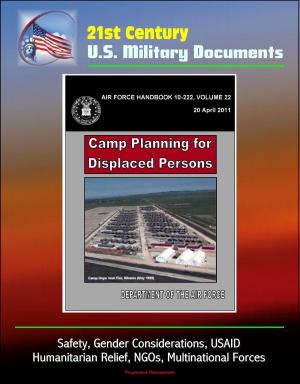Operational Reconnaissance: Identifying the Right Problems in a Complex World – Case Studies of World War II and 2006 Israeli-Hezbollah War, Intelligence Objectives, Capabilities, and Planning
Nonfiction, History, Military, United States, World War II| Author: | Progressive Management | ISBN: | 9781370042722 |
| Publisher: | Progressive Management | Publication: | February 11, 2017 |
| Imprint: | Smashwords Edition | Language: | English |
| Author: | Progressive Management |
| ISBN: | 9781370042722 |
| Publisher: | Progressive Management |
| Publication: | February 11, 2017 |
| Imprint: | Smashwords Edition |
| Language: | English |
This excellent report has been professionally converted for accurate flowing-text e-book format reproduction. The Army deploys to complex operational environments characterized by multiple agents, opaque social networks and multiple, inter-related systems. Frequently, assumptions made in developing plans are proven incorrect when forces actually interact with these complex environments. As a result, actions by Army forces can be counter-productive in achieving the desired strategic aims. This paper proposes a model for the development of an operational reconnaissance force, and explores its development and conceptual usage in World War II and the 2006 Israeli-Hezbollah War.
Operational reconnaissance seeks to interact with the complex environment to improve the operational commander's understanding and their ability to detect changes occuring within it. It is characterized by a requirement to support the operational commander, its integration into planning, its focus, and the necessary capabilities required to provide operational organizations with timely and useable information. The concept of operational reconnaissance develops its intellectual foundations amongst German, Soviet, and US theorists from the interwar period. Subsequent experiences from World War II further shaped the requirements necessary to conduct operational reconnaissance against a near peer adversary. The 2006 Israeli-Hezbollah War offers an opportunity to explore the evolution of the requirements necessary to conduct operational reconnaissance against an asymmetric threat in order to develop a more robust model nested within modern doctrine.
The United States collects information through the use of extensive strategic and operational intelligence capabilities that generally provide it with a significant advantage over its rivals both prior to and during a conflict. The term rival incorporates the complexity of the operational environment that may not necessarily include violence to defeat an antagonist, whereas an enemy is used in circumstances of war. The US advantage is not without its limitations. The Army currently lacks the capability to actively gain operational intelligence within an area of operations prior to the commitment of main body forces. The concept of operational reconnaissance is a tool to gain operational intelligence in a complex environment. Operational reconnaissance is defined as reconnaissance conducted prior to and during campaigns to support the operational commander in the development or modification of an operational approach and to inform command decisions. There are two likely answers for the lack of operational reconnaissance within the current force structure or doctrine: either the current intelligence system meets the needs for the operational level of war or there is a capability gap that needs to be identified and addressed. This monograph proposes that it is a capability gap the Army needs to fill to improve the agility of the US Army to adapt to complex environments in the future. The US Army can employ operational reconnaissance through an adaptive reconnaissance organization that integrates information collection capabilities, interacts with and evaluates relationships within the operational environment, and informs the operational commander. Recent experience and the nature of the contemporary operational environment demonstrate a need to understand rivals prior to an action.
This excellent report has been professionally converted for accurate flowing-text e-book format reproduction. The Army deploys to complex operational environments characterized by multiple agents, opaque social networks and multiple, inter-related systems. Frequently, assumptions made in developing plans are proven incorrect when forces actually interact with these complex environments. As a result, actions by Army forces can be counter-productive in achieving the desired strategic aims. This paper proposes a model for the development of an operational reconnaissance force, and explores its development and conceptual usage in World War II and the 2006 Israeli-Hezbollah War.
Operational reconnaissance seeks to interact with the complex environment to improve the operational commander's understanding and their ability to detect changes occuring within it. It is characterized by a requirement to support the operational commander, its integration into planning, its focus, and the necessary capabilities required to provide operational organizations with timely and useable information. The concept of operational reconnaissance develops its intellectual foundations amongst German, Soviet, and US theorists from the interwar period. Subsequent experiences from World War II further shaped the requirements necessary to conduct operational reconnaissance against a near peer adversary. The 2006 Israeli-Hezbollah War offers an opportunity to explore the evolution of the requirements necessary to conduct operational reconnaissance against an asymmetric threat in order to develop a more robust model nested within modern doctrine.
The United States collects information through the use of extensive strategic and operational intelligence capabilities that generally provide it with a significant advantage over its rivals both prior to and during a conflict. The term rival incorporates the complexity of the operational environment that may not necessarily include violence to defeat an antagonist, whereas an enemy is used in circumstances of war. The US advantage is not without its limitations. The Army currently lacks the capability to actively gain operational intelligence within an area of operations prior to the commitment of main body forces. The concept of operational reconnaissance is a tool to gain operational intelligence in a complex environment. Operational reconnaissance is defined as reconnaissance conducted prior to and during campaigns to support the operational commander in the development or modification of an operational approach and to inform command decisions. There are two likely answers for the lack of operational reconnaissance within the current force structure or doctrine: either the current intelligence system meets the needs for the operational level of war or there is a capability gap that needs to be identified and addressed. This monograph proposes that it is a capability gap the Army needs to fill to improve the agility of the US Army to adapt to complex environments in the future. The US Army can employ operational reconnaissance through an adaptive reconnaissance organization that integrates information collection capabilities, interacts with and evaluates relationships within the operational environment, and informs the operational commander. Recent experience and the nature of the contemporary operational environment demonstrate a need to understand rivals prior to an action.















